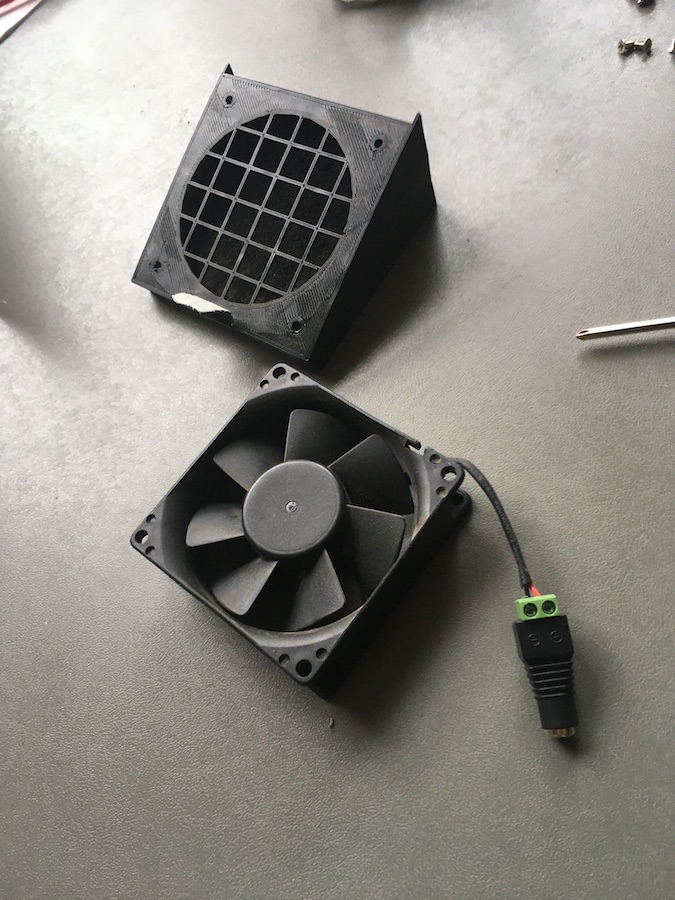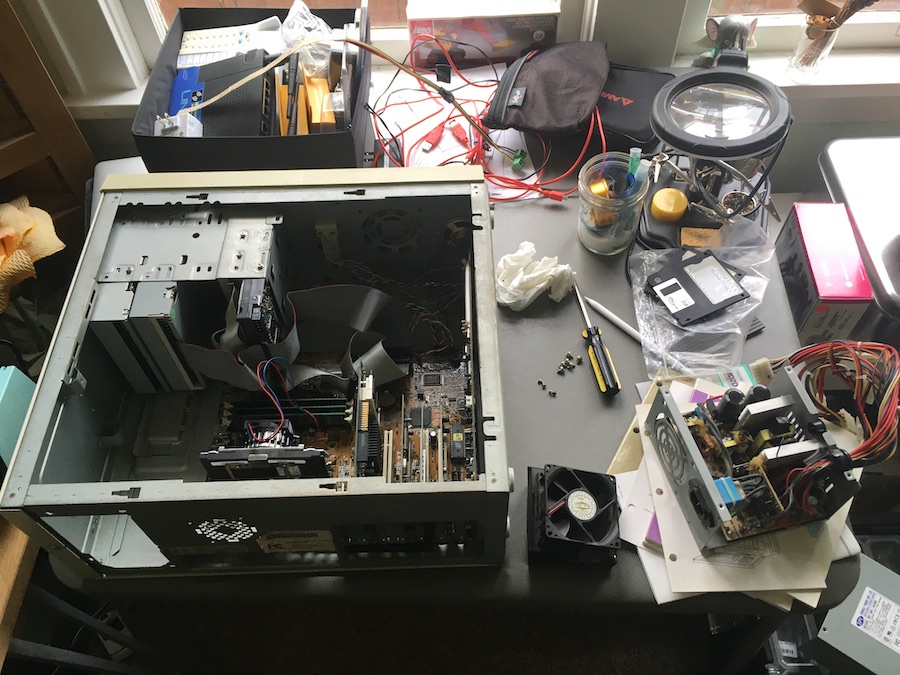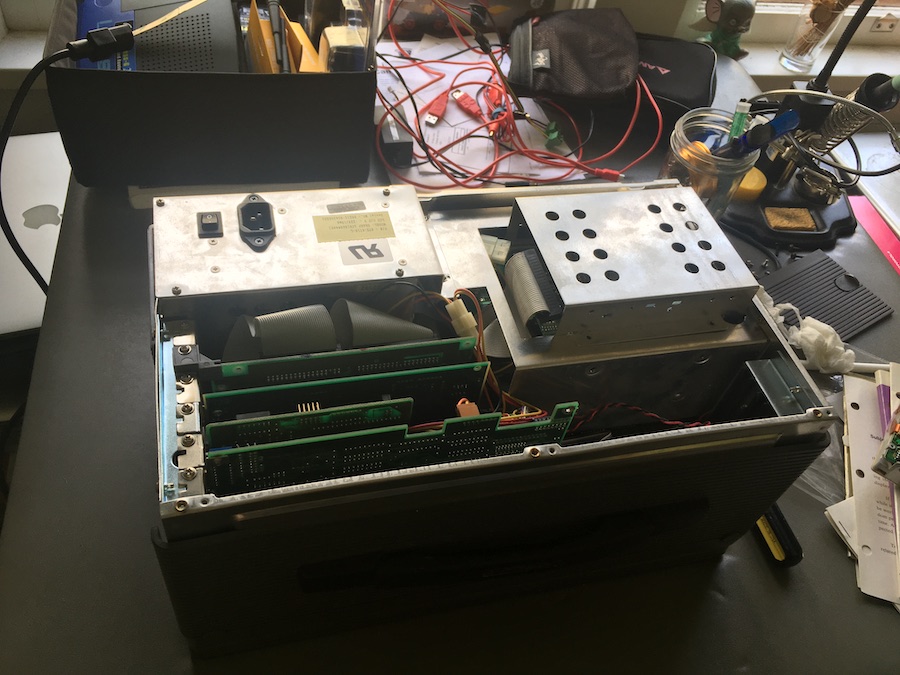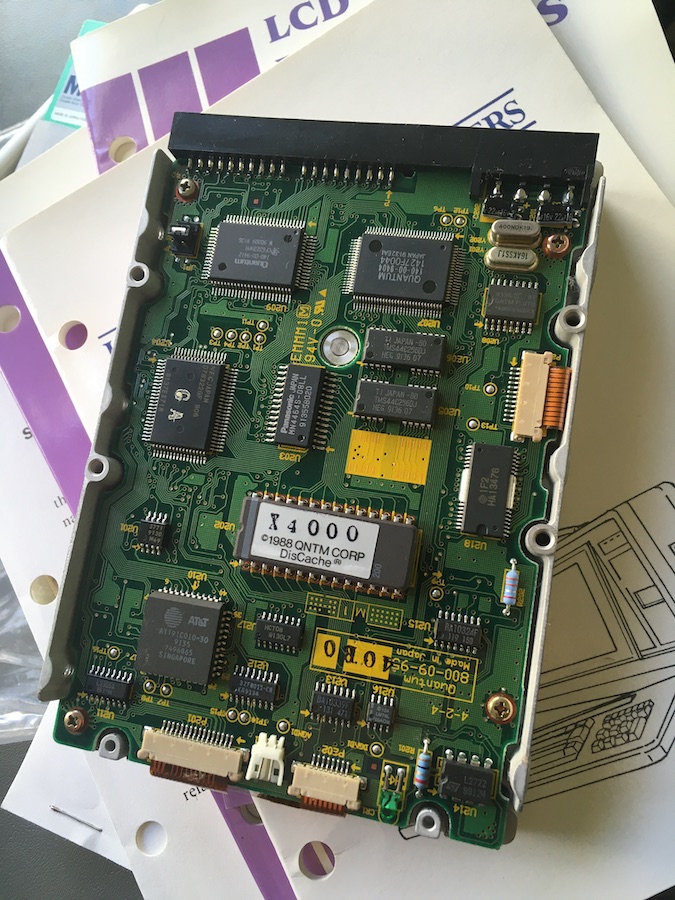Project 386 #1: The acquisition and some personal computing history
Last week, via my local Dorkbot mailing list, I acquired a pretty cool-looking late-80s portable computer.

It clocks in at about thirty pounds, but comes complete with a built-in keyboard, both 5.25" and 3.5" floppy drives, an internal hard drive, and, added on later, a wired network card. Oh, and a handle clearly labeled PORTABLE. That must be for encouragement as you begin to pick it up, question the wisdom/feasibility of your decision, and finally push on through to the eventual overcoming of gravity.

I’m hoping to dig into it, revive it, and, since it is the oldest computer capable of it, installing and running an ancient variant of Linux on it. Finally, I hope to use it for some public art or other interactive exploration. More on that later in a future missive…
First, spoiler alert: as of my first time sitting down with the machine, the most I could get it to do was the beep loudly and continuously, with no picture on the built-in display or, by flipping some DIP switches on the side, with an external monitor (in this case, the only VGA-compatible display that I have in the house is our TV). My next step is to revive a different old PC that I have: my old 800 MHz FreeBSD-based desktop computer with the triple threat of internet access, a CD burner, and a floppy drive, in order to diagnose what’s going on with the new portable and what I can do about it.
I’d like to share some history on why this project is interesting to me.
I never had a computer of this caliber in its prime, but I dreamt of one. The computers that took me from the 80s into the late 90s were:
-
A Texas Instruments TI-99/4A c. 1981, which I got in the late 80s at a thrift store. I ran mine off of a black & white TV, so I had to be creative when it came to graphics programming. I saved and loaded programs on cassette tapes. I wrote a lot of BASIC.
-
An IBM PCjr c. 1984, which I got in 1992, built on the venerable 8088 chip. Mine had a second “deck” with an additional 5.25" floppy drive, a sidecar with an extra 512KB of RAM, and a 110 baud modem which I never connected to the internet. No hard drive, so I had
A:andB:but only longed for aC:. I think I did manage a RAM disk with some letter likeR:, though. It had a color monitor. I remember It came with a bunch of crappy 4-color software on floppies, like an anatomy quiz game, a checkbook-balancing suite, and a word processor. I wrote a lot of BASIC. -
In middle and high school, I used the RadioShack TRS-80, the Apple IIe, and I learned how to touch type on the Apple IIGS. For desktop publishing with the school newspaper and yearbook, I got into the Apple Macintosh Performa. I wrote a lot of BASIC.
-
Once I got to college, it was a very UNIX-centric engineering school, and I was exposed to Sun Solaris, SGI IRIX, IBM AIX, and the like. It was on these sorts of computers that I first got on the internet, at a time when almost all of the internet ran on proprietary UNIX-based operating systems. My UNIX roots run deep. Here I moved on to Perl and Bash scripting. No more BASIC! I kind of miss it.
-
Finally, in 1998 at the age of twenty-one, I acquired a Gateway credit card for the express purpose of maxing it out on a brand new, not-built-by-Gateway Pentium II-based computer (from “Midwest Micro”, via a recommendation from my coworker at RadioShack), on which I promptly installed Red Hat Linux 5.1 and got to self-teaching the skills that would take me into a computer career and, eventually, way on down the road, paying off that maxed-out credit card. I spent the weeks between pre-buying the Linux floppies and the arrival of the computer poring over the manual and learning everything I could about getting a UNIX-like system going on your own, personal computer.
Rewinding to the 80s for a moment, my lone 386 experience: a friend borrowed from a relative a modern PC (turbo button and all; I believe it toggled between 25 and 33 MHz) with a CD-ROM drive featuring a full encyclopedia, complete with an actual video movie—with sound—of a tiger. We had access for a few weeks, but due to budgetary constraints (yeah… that was it) we played Nintendo instead of working on the intricacies of getting that computer to run software beyond what came with it. But mostly, I fell back to my PCjr, a nearly decade-old claptrap of a machine with a cult following but with little ability to do anything cool since I was offline, far away from any sort of nexus of cool tech activity, and it was a strange outlier in the IBM PC family tree and was hard to get good, or at least modern, software for.
Still, I have a special place in my heart for this era of computer. I would buy floppies of shareware at the mall dollar store to try out, or occasionally a game from the electronics store or from a yard sale in the hopes that it would support Tandy’s TGA 16-color graphics and maybe, just maybe, my PCjr’s weird EGA mode, or the PCjr’s better-than-PC-but-still-not-SoundBlaster three-voice sound so that I could run a game with graphics in more than four colors and beeps. It rarely happened. I envied kids at school with 256-color VGA, playing King’s Quest.
Back to the portable, as mentioned above, I had to first take a sidequest to revive my old desktop FreeBSD PC as a link for debugging the portable. About a year ago, I cut out its power supply cooling fan to combine with a 3D printed enclosure and a carbon filter cut from our countertop composting bin in order to make a soldering fume extractor for my desk. This was a challenge project that I do sometimes—make a thing without leaving the house for supplies (easier in these times of COVID-19) and being creative with what is around me.

I got that fan soldered back into the PC last night and got it safely—and cooly 😎—up and running. The OS is FreeBSD 6.1 from 2006 and I hadn’t logged in since October 2010. But everything was as I had left it, I was able to login and get it booted, and immediately was presented with a LAN Bonjour-advertised, AFP-compatible share of non-essential files from that time period.

Next up, I’m going to try to get some sort of bootable 3.5" floppy going—maybe Linux or FreeBSD, maybe MS-DOS? We’ll see. I also hope to share some more info on the paperwork and software that came with this portable, and to otherwise document its interesting form factor and hardware.



At its base, I’m hoping to use my old PC, basically a “686”, to revive an 80386 and relive my days of the 8088. Won’t you come along for the ride?
Bonus: this is about the only video I can find about this sort of computer so far, a WIRED look back.